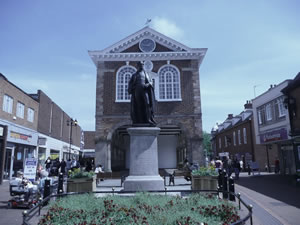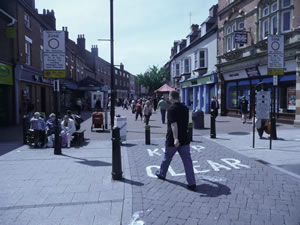Tamworth, Staffordshire
Tamworth is a bustling market town with many historic buildings including the famous castle. Only 17 miles from Birmingham in the midlands. There are wonderful facilities such as the Snowdome, Drayton Manor Park & Zoo, great shopping in the markets, town centre and the Ankerside Shopping Centre. Cafes, Bars & Restaurants. With excellent road and rail links .
Statue of Sir Robert Peel

Outside Town Hall

Outside Town Hall
The town's main employers include logistics, engineering, clothing, brick, tile and paper manufacture. It was also home to the Reliant car company, which produced the famous three-wheeled Robin model and the Scimitar sportscar for several decades. Many people commute to Birmingham.
Places to visit in Tamworth
Tamworth Castle - In the town centre and is the main attraction for Tamworth. There is the amazing Medieval Great Hall, Grand Tudor Chambers and Victorian Suit of reception rooms.
Planet Walk - in the grounds of the caslte see some lovely sculpture
Treasure Island - In the castle pleasure grounds a themed play area for children under 6
The Snowdome - with real snow and a 170 metre slope all year round fun
Tamworth Assembly Rooms - The entertainment venue in Tamworth - listed building
St Editha's Church - A fabulous building steeped in local history
Tamworth Information Centre - on Market Street great for local knowledge
The Town Hall & Statue of Robert Peel a important local historic figure
Ankerside Shopping Centre - with all the main shops
Namco Strykers bowling and entertainment centre on River Drive
Drayton Manor Park & Zoo - a great day out for the whole family.
History
Tamworth has existed since Saxon times, and once was the capital of Mercia, the largest of all English kingdoms of its time. It was by far the largest town in the Midlands when today's much larger city of Birmingham was still in its infancy. This is largely because of its strategic position at the meeting point of two rivers (the Tame and the Anker), which meant the town was perfectly placed as a centre of trade and industry.

The town was later sacked by Danes in the 9th century, and what is known is that there was a wooden fort, probably constructed on the site of today's castle, designed to defend the town against further Danish invaders by Ethelfleda, Lady of the Mercians, the daughter of King Alfred the Great.
In the 11th century, a Norman castle was built on the probable site of the Saxon fort, which still stands to this day as an important tourist attraction. Grants of borough privileges, including rights to a third additional fair in 1588, consolidated Tamworth's historic importance as 'the seat of Saxon kings'.
In the Middle Ages Tamworth was a small market town. However the king gave it charters in 1319. (In the Middle Ages a charter was a document granting the townspeople certain rights or confirming existing ones). In 1337 Tamworth was granted the right to hold two annual fairs. (In the Middle Ages fairs were like markets but they were held only once a year and they attracted buyers and sellers from far and wide).
In 1345 Tamworth suffered a disastrous fire. Much of the town burned[2]. (Fire was a constant hazard in the Middle Ages because most buildings were made of wood with thatched roofs. On the other hand if they burned they could be easily rebuilt).
Tamworth continued to grow and remained of the most populous towns in the Midlands by 1670, when the combined hearth tax returns from Warwickshire and Staffordshire list a total of some 320 households. Its strategic trade advantage lay with control of the two vital packhorse bridges across the Anker and the Tame on the route from London to Chester. While it remained a local market town, it did a brisk trade providing travellers with the staple bread, ale and accommodation, maintaining trading links as far afield as Bristol. Charles II's reconfirmation of its borough's privileges in 1663 gave the town an added boost, as confirmed by Richard Blome's description of its celebrated market, well served with corn, provisions and lean cattle.
Queen Elizabeth granted Tamworth another charter in 1560.
In the 16th and 17th centuries Tamworth, like all towns, suffered from outbreaks of plague. It struck in 1563, 1579, 1597-98, 1606 and 1626. Each time the plague struck many people died but each time the population recovered. Fortunately the 1626 outbreak was the last.
In 1678 a man named Thomas Guy founded almshouses in Tamworth (they were rebuilt in 1913). He also built Tamworth Town Hall in 1701 and later founded Guys Hospital in London.
There are four cannons in the Castle Grounds, an indication of the town's previously violent past.
In 1801, the population was a little over 3001.
There were a number of improvements to Tamworth during the 19th century. In 1807 the pavements were flagged. From 1835 Tamworth had gaslight. In the late 19th century a piped water supply was created.
The town grew rapidly in the 18th and 19th centuries during the Industrial Revolution, due largely to the surrounding coal mines. It also became a hub of the canal network, with the Coventry Canal and the Birmingham and Fazeley Canal being built through the town. Later the railways arrived with the Midland Railway route from Derby to Birmingham arriving in Tamworth in 1847, and later the London and North Western Railway, which provided direct trains to the capital. A split-level station exists where the two main lines cross one-another, the higher level platforms (on the Derby to Birmingham line), being at right angles to the lower ones on the main line to London.
The first cemetery opened in 1876. The Assembly Rooms were built in 1889. In 1897 the corporation bought Tamworth Castle.
A hospital was built in Tamworth in 1880. An infirmary was built in 1903.
The first council houses in Tamworth were built in 1900. More were built in the 1920s and 1930s and after 1945.
The first public library in Tamworth was built in 1905. Tamworth gained an electricity supply in 1924.
The Victorian Prime Minister Sir Robert Peel served as the town's MP from 1830 until his death in 1850. It was in Tamworth that Robert Peel unveiled his Tamworth Manifesto in 1834 which created what is now the modern Conservative Party. During the 19th century a breed of pig called Tamworth Pig was initially bred here using some imported Irish stock.
Samuel Parkes who won the Victoria Cross in the Charge of the Light Brigade was born in Wiggington and baptised at St Editha's on 24 December 1815. His parents, Thomas and Lydia, are buried in its churchyard.
Tamworth has grown rapidly in the postwar years due to overspill from the West Midlands conurbation to the southwest. A population of about 7,000 in 1931 had risen to some 13,000 just after World War II; this figure remained fairly static until the late 1960s when a major expansion plan was implemented. Although not officially a "New Town", Tamworth developed like one for a time. As part of this plan the town boundaries were expanded to include the industrial area around Wilnecote to the south. The 1961 population of the new enlarged area was 25,000. In 1971 it was 40,000; in 1981, 64,000; in 1991, 68,000 and in 2001, 74,000. The target population is c.80,000.
The town of Fazeley merges almost completely into the town to the southwest, and belongs to the Lichfield District area rather than Tamworth Borough. It became a town, by holding a referendum, to prevent efforts from Tamworth to absorb it
Tamworth was historically split between Staffordshire and Warwickshire, with the county boundary running through the town centre. Staffordshire was made to include the entire borough in 1888.
The A5 £26,000,000 8 km (5 mile) dual-carriageway 'Fazeley, Two Gates and Wilnecote Bypass' opened in July 1995, acting both as a bypass of Watling Street, and as a fast route for traffic into the town. This was further extended to meet the M6 Toll and A38 in 2005.
Links:
